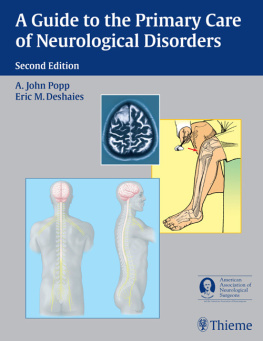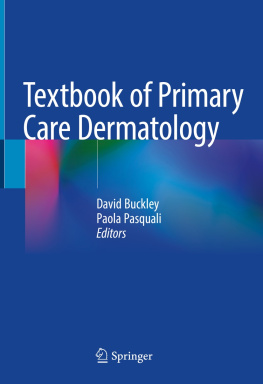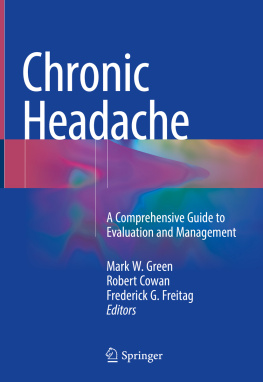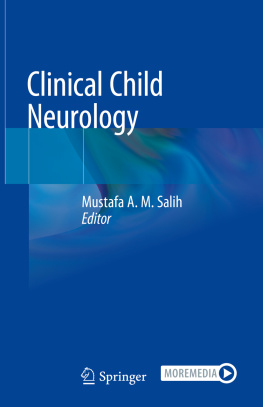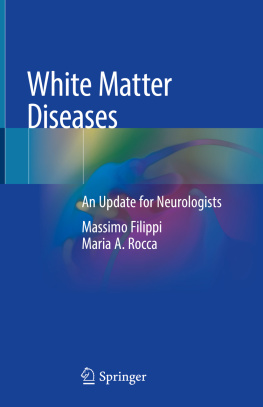A Guide to the Primary Care of Neurological Disorders
Second Edition
A. John Popp, M.D.
Henry and Sally Schaffer Chair and Professor of Surgery
Co-Director of the Neurosciences Institute
Albany Medical Center
Albany, New York
Associate Editor
Eric M. Deshaies, M.D.
Resident in Neurosurgery
Neurosciences Institute
Albany Medical Center
Albany, New York
Thieme
New York Stuttgart
American Association of Neurosurgeons
Rolling Meadows, Illinois
| Thieme Medical Publishers, Inc. | American Association of Neurosurgeons (AANS)* |
| 333 Seventh Ave. | 5550 Meadowbrook Drive |
| New York, NY 10001 | Rolling Meadow, Illinois 600083852 |
The acronym AANS refers to both the American Association of Neurological Surgeons and the American Association of Neurosurgeons.
Editor: Birgitta Brandenberg
Vice President, Production and Electronic Publishing: Anne T. Vinnicombe
Production Editor: Heidi Pongratz, Dovetail Content Solutions
Vice President, International Marketing: Cornelia Schulze
Sales Director: Ross Lumpkin
Chief Financial Officer: Peter van Woerden
President: Brian D. Scanlan
Compositor: Thomson Digital Services
Printer: The Maple Press book Manufacturing Group
Cover illustration from Thieme Atlas of Anatomy by Markus Voll
Library of Congress Cataloging-in-Publication Data
A guide to the primary care of neurological disorders / edited by A. John Popp, Eric M. Deshaies. 2nd ed.
p. ; cm.
Includes bibliographical references and index.
ISBN 978-1-58890-516-1
1. Nervous systemDiseases. 2. Primary care (Medicine) I. Popp, A. John, 1941- II. Deshaies, Eric M. III. American Association of Neurosurgeons.
[DNLM: 1. Nervous System Diseases. 2. Primary Health Caremethods. WL 140 G9465 2007]
RC346.G88 2007
616.8dc22
2007019027
Copyright 2008 by Thieme Medical Publishers, Inc. This book, including all parts thereof, is legally protected by copyright. Any use, exploitation, or commercialization outside the narrow limits set by copyright legislation without the publishers consent is illegal and liable to prosecution. This applies in particular to photostat reproduction, copying, mimeographing or duplication of any kind, translating, preparation of microfilms, and electronic data processing and storage.
Important note: Medical knowledge is ever-changing. As new research and clinical experience broaden our knowledge, changes in treatment and drug therapy may be required. The authors and editors of the material herein have consulted sources believed to be reliable in their efforts to provide information that is complete and in accord with the standards accepted at the time of publication. However, in view of the possibility of human error by the authors, editors, or publisher of the work herein or changes in medical knowledge, neither the authors, editors, nor publisher, nor any other party who has been involved in the preparation of this work, warrants that the information contained herein is in every respect accurate or complete, and they are not responsible for any errors or omissions or for the results obtained from use of such information. Readers are encouraged to confirm the information contained herein with other sources. For example, readers are advised to check the product information sheet included in the package of each drug they plan to administer to be certain that the information contained in this publication is accurate and that changes have not been made in the recommended dose or in the contraindications for administration. This recommendation is of particular importance in connection with new or infrequently used drugs.
Some of the product names, patents, and registered designs referred to in this book are in fact registered trademarks or proprietary names even though specific reference to this fact is not always made in the text. Therefore, the appearance of a name without designation as proprietary is not to be construed as a representation by the publisher that it is in the public domain.
Printed in the United States of America
5 4 3 2 1
The Americas ISBN: 978-1-58890-516-1
Rest of the World ISBN: 978-3-13-135122-7
Dedication
To my muse, MMV
A.J.P.
Contents
Bruce Bagley
Todd A. Maugans
A. John Popp, Venkat Ramani, John Morihisa, and Bruce I. Tranmer
Dale L. Moore
Dan M. Mayer and John B. Chessare
John B. Chessare
Sharon Habiniak, Allison Goodell, and Elizabeth B. Anderson
Dan M. Mayer and John B. Chessare
Mark P. Dentinger
Clifford J. Belden and William A. Wagle
Venkat Ramani, James R. Storey, and Neil Lava
Darryl DiRisio, Eric M. Deshaies, Matthew A. Adamo, Daniel Friedlich, Dorota Hausner-Sypek, George P. Forrest, and A. John Popp
Mark P. Dentinger
Howard Smith and A. John Popp
James R. Storey
Eric S. Molho, Donald S. Higgins, and Dzintra F. Celmins
Gregory T. Hofeldt, Paul M. Taupeka, John W. Simon, and Gregory B. Krohel
Steven M. Parnes
Steven M. Parnes
Anthony L. Ritaccio
Victoria Balkoski, C. Deborah Cross, and Irwin N. Hassenfeld
Venkat Ramani
Anthony L. Ritaccio
Bruce I. Tranmer, Michael A. Horgan, Leonardo P. Ribeiro, and A. John Popp
Darryl DiRisio, Eric M. Deshaies, Daniel Friedlich, Matthew A. Adamo, and A. John Popp
Bruce I. Tranmer, Christopher S. L. Commichau, and A. John Popp
Eric M. Deshaies, Alan S. Boulos, Bruce I. Tranmer, and A. John Popp
Joseph F. Emrich, Matthew A. Adamo, Bruce I. Tranmer, and A. John Popp
Martha L. Lepow and Patricia A. Hughes
Kevin D. Barron
John B. Waldman, Matthew A. Adamo, Jerome S. Haller, and Elaine Schulte
David J. Coffey, Todd A. Maugans, and Lawrence R. Jenkyn
Rebecca Jeanmonod and Mara McErlean
George P. Forrest
Foreword
Primary care serves a central role in the complex health-care system in the United States. Family physicians, internists, and pediatricians along with nurse practitioners, physicians assistants, and other members of the care team provide a personal medical home for the majority of patients in this country. These dedicated professionals accept the challenge and responsibility of sorting out a myriad of symptoms and complaints, and then determining which ones might have clinical significance to the patient or signal more serious or unusual disease.
Specialists in the neurosciences as well as other areas of medicine have an ongoing responsibility to train medical students, residents, and practicing physicians in the basic knowledge and latest advances in their chosen specialty areas. Armed with this knowledge, primary care physicians can make timely diagnostic, treatment, and referral decisions in the context of patient choice and the resources within their communities. In this latest edition of A Guide to the Primary Care of Neurological Disorders, John Popp, M.D., and colleagues offer a single volume filled with useful information and the wisdom that comes from long experience in treating neurological conditions.
This latest edition is organized and presented in a way that allows the reader to choose either a chapter-by-chapter approach or to easily access specific information needed to answer clinical questions at the point of care. The full read approach provides the physician with comprehensive yet practical coverage of the common neurological disorders. It is this fund of knowledge that prepares the front-line clinician to make the early diagnosis of the acute onset of Guillain-Barr syndrome or to sort out which patients with peripheral nerve syndromes need conservative management versus immediate intervention.
The unique organization of this book also allows clinicians to efficiently find the answers to specific clinical questions that arise at the point of care, socalled just-in-time education. Physicians will find it a valuable resource to review diagnostic criteria or to obtain guidance for diagnostic workup, referral, or therapeutic recommendations. Each chapter is designed to review the latest understanding of the pathophysiology, diagnosis, and treatment of a condition. The referral guidelines have been constructed and presented to provide guidance for primary care physicians that can be translated into action in the context of local community resources and the availability of specialty consultation and referral centers.
Next page
